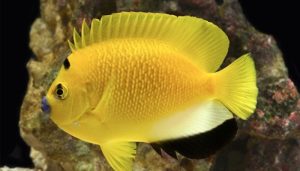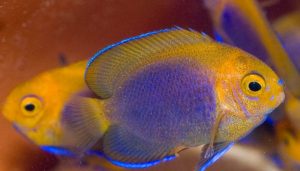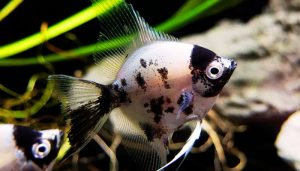Why do baby snails appeared in my fish tank? If you’ve recently noticed that baby snails appeared in your aquarium, you might be wondering whether this unexpected arrival is a cause for concern or a pleasant surprise.
These tiny newcomers can evoke mixed reactions, especially for both seasoned aquarium enthusiasts and beginners alike. While some view baby snails as adorable additions to their underwater ecosystem, others fear they may cause more harm than good.
So, what does it mean when baby snails suddenly pop up in your tank? Are they harmless cleaners, or should you worry about them disrupting your fish’s environment?
In this post, we’ll dive into the possible benefits and drawbacks of having baby snails in your tank. We’ll also explore how they ended up there in the first place and what steps you can take to control or welcome them.
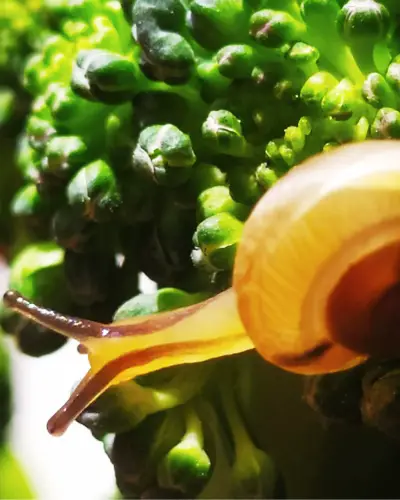
Ready to find out if these tiny visitors are friends or foes to your aquatic setup? Keep reading to discover what these baby snails might mean for your fish tank’s health!
Table of Contents
ToggleSnail appeared suddenly in the aquarium, is that normal?
It is not uncommon for snails to appear suddenly in aquariums. Snails are often inadvertently introduced into aquariums through live plants or even on the shells of other aquatic creatures.
They may enter the aquarium as tiny eggs attached to decorations or burrow under the substrate. While some aquarium owners may find snails a nuisance, they can actually benefit the aquarium ecosystem.
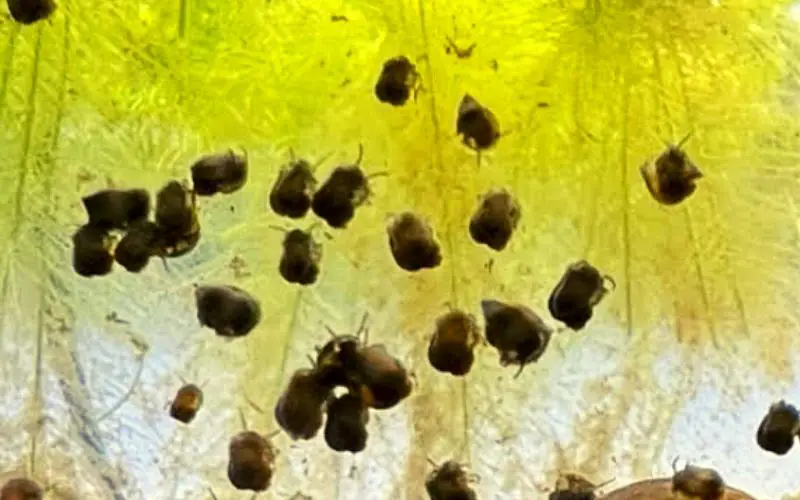
Snails help clean up algae and decaying plant matter and can also serve as a food source for some fish. That being said, some species of snails can reproduce quickly and overpopulate a tank if not kept in check.
Suppose you find unexpected snails in your aquarium. In that case, you may keep them and monitor their population, or you can try to remove them manually if you are concerned about overpopulation. Ultimately, the appearance of snails in an aquarium is not abnormal and can contribute to the overall health of the tank.
What are Pest Snails in an Aquarium?
Pest snails in an aquarium refer to those snails that can quickly multiply and overrun a tank, causing damage to the plants and disturbing the overall balance of the ecosystem.
These small snails are often introduced inadvertently through live plants or decorations and can reproduce rapidly in the right conditions. While some hobbyists may find them a nuisance, others may not mind their presence.
However, if left unchecked, their numbers can grow out of control and become detrimental to the health of the aquarium. Various methods exist for controlling pest snails, such as manually removing them, introducing natural predators, or using commercial treatments.
Aquarium hobbyists must be aware of these potential invaders and take proactive measures to manage their population.
Why are there Baby Snails Appeared in My Fish Tank?
Baby snails appearing in your fish tank can be a surprise, but there are a few common reasons why it might happen:
1. Hitchhikers: The most likely culprit is hitchhiking. Snails, or their eggs, can easily come in on new plants, decorations, or even gravel from other tanks. They’re often tiny and hard to spot, so you might only realize they’re there once they start reproducing.
2. Overfeeding: Snails thrive on excess food and residue. Overfeeding your fish or not cleaning the tank regularly creates a buffet for snails, leading to a population boom.
3. Existing adults: Did you intentionally add adult snails to your tank at some point? Even a small number can reproduce quickly under the right conditions.
4. Specific snail types: Certain snail species, like Malaysian Trumpet Snails, are prolific breeders and can quickly overrun a tank if left unchecked.
Are they a problem?
It depends! Some snail species, like Malaysian Trumpet Snails, can be considered pests because they reproduce rapidly and compete with fish for food. However, other snails, like Mystery Snails or Nerite Snails, can be beneficial by eating algae and detritus, acting as natural tank cleaners.
Are pest snails bad for your freshwater aquarium?
The term “pest snail” is a bit of a misnomer, as most snails found in freshwater aquariums can be beneficial. They help to clean the tank by eating algae, uneaten food, and detritus (waste). However, some species can reproduce quickly and become overwhelming if the aquarium needs to be properly maintained.
Here’s a breakdown of the pros and cons of having snails in your freshwater aquarium:
Pros:
- Clean-up crew: Snails help to keep your aquarium clean by eating algae, uneaten food, and detritus. This can help to improve water quality and reduce the risk of harmful bacteria growth.
- Natural part of the ecosystem: Snails are an important part of the natural ecosystem in freshwater environments. They help to break down organic matter and cycle nutrients.
- Food for other fish: Some fish, like loaches and puffers, enjoy eating snails. This can be a good way to control the snail population in your tank.
Cons:
- Can reproduce quickly: Some species of snails can reproduce very quickly, especially if plenty of food is available. This can lead to an overpopulation of snails, which can be unsightly and compete with other tank inhabitants for food.
- May damage plants: Some species of snails, such as mystery snails, can damage delicate plants.
- Can be difficult to remove: If you decide that you don’t want snails in your tank, it can be difficult to remove them completely.
Here are some tips for managing the snail population in your freshwater aquarium:
- Maintain good water quality: This will help to reduce the amount of food available for snails.
- Refrain from feeding your fish: This will also help to reduce the amount of food available for snails.
- Manually remove snails: If you see a few, you can manually remove them from your tank.
- Use snail traps: There are several snail traps available that can help you to remove unwanted snails.
- Introduce snail predators: Some fish, such as loaches and puffers, will eat snails. However, be sure to choose fish that are compatible with your other tank’s inhabitants.
Ultimately, whether or not pest snails are bad for your freshwater aquarium is up to you. They can be beneficial if you don’t mind having a few snails in your tank. However, if you find that the snail population is getting out of control, there are several things you can do to manage it.
What to Do When Snails Suddenly Appear? (Aquatic Solutions)
- Identify the snails: Knowing what type of snail you have will help you decide how to manage them.
- Control food: Reduce the amount you feed your fish and remove uneaten food promptly. This will limit the available food for snails.
- Manual removal: You can physically remove some snails by hand or with a net. However, there might be more effective options for controlling large populations.
- Snail traps: There are various snail traps available that can help you catch and remove unwanted snails.
- Predators: Add snail-eating fish, like loaches or puffers, to your tank. However, be sure they are compatible with your existing fish.
- Biological control: Some fish stores sell products containing snail-eating nematodes, which can help control snail populations naturally.
- A helpful method to control the snail population involves placing a piece of lettuce on a plate in your tank overnight and removing it in the morning. This technique attracts snails, as they are known to gather on the lettuce, allowing for easy removal.
Ultimately, deciding how to deal with the baby snails is up to you. If they’re not causing any problems and you don’t mind their presence, you can leave them be. But if they’re becoming a nuisance or competing with your fish, there are steps you can take to control their population.
Where do aquarium snails come from?
Aquarium snails come from various parts of the world, and their origin depends on the specific species. Many aquarium snails are native to Southeast Asia, Africa, and South America freshwater habitats.
Some species have been introduced to new areas through aquarium trade or accidental snails laying eggs, and they may have established wild populations in those regions.
Popular aquarium snail species, such as the common aquarium snail (Physella acuta) or the Malaysian trumpet snail (Melanoides tuberculata), are originally from North America and Southeast Asia, respectively. Mystery snails (Pomacea diffusa) are native to South America.
There are also apple snails (Pomacea canaliculata and Pomacea bridgesii), native to South America but have become invasive in some parts of the world.
It’s important to note that some snails can reproduce rapidly and become pests in aquariums if their populations are not carefully managed. Therefore, it’s advisable to research the specific species and their requirements before introducing snails into an aquarium.
Do Malaysian trumpet snails eat other snails?
Malaysian trumpet snails (MTS) generally do not eat other snails. They are primarily scavengers and detritivores, meaning they feed on Algae, Detritus, and Microscopic organisms.
While they might scavenge on a dead snail if they come across it, they don’t actively hunt or prey on live snails. This makes them peaceful tank mates for other snail species like mystery, nerite, and ramshorn snails.
Malaysian trumpet snails are unlikely to bother other snails, making them suitable tank mates for many species. But be mindful of potential competition and predators and manage their population size if needed.
Are Ramshorn Snails a problem?
Ramshorn snails can be both beneficial and problematic in an aquarium. On one hand, they serve as detritivores, feeding on algae, decaying plant matter, and leftover fish food, helping to keep the tank clean.
They can also indicate poor water quality, as their population may explode in response to an overabundance of nutrients in the water.
However, their rapid reproduction can lead to overpopulation, a problem in a closed system like an aquarium. If not properly managed, they can quickly overwhelm a tank, covering surfaces and competing with other inhabitants for resources.
Additionally, their voracious appetite for live plants can be frustrating for aquarium owners who have carefully cultivated their aquatic landscape. Therefore, keeping an eye on the population and implementing control measures when necessary is essential to prevent Ramshorn snails from becoming a problem.
Are bladder snails bad for tanks?
Whether bladder snails are bad for your tank depends on your perspective and setup. Here’s a breakdown of their pros and cons:
Pros:
- Algae control: Bladder snails are excellent scavengers and algae eaters, helping to keep your tank clean. They consume detritus, biofilm, and algae, which can otherwise contribute to poor water quality.
- Waste management: They help break down fish waste, further aiding in maintaining good water parameters.
- Peaceful: They are peaceful creatures and won’t harm other fish or plants.
- Low maintenance: They require no special care and can thrive in various water conditions.
Cons:
- Fast reproduction: They can reproduce quickly, especially if abundant food is available. This can lead to a population explosion, which some find unsightly.
- Plant nibbling: While primarily algae eaters, they may nibble on young or delicate plants, especially if other food sources are scarce.
- Calcium depletion: Their shells require calcium, which can deplete the supply in smaller tanks, potentially impacting other calcium-dependent inhabitants like shrimp.
Overall, Bladder snails are generally considered beneficial for most tanks. However, their population may need control if you have a heavily planted tank or prefer a minimalist aesthetic.
How do you get rid of pest aquarium snails?
There are a few different methods for getting rid of snails. One option is to remove the snails by hand manually. This can be time-consuming, but it can be effective for smaller infestations.
Another method is introducing snail-eating fish, such as loaches or pufferfish, into the aquarium. These fish will help keep the snail population in check. Additionally, some aquarium owners use chemical treatments to kill off the snails.
However, it’s important to follow the instructions for any chemical treatments carefully and to be mindful of the impact they may have on the other inhabitants of the aquarium.
Finally, some people use natural remedies, such as adding certain plants or vegetables to the aquarium to repel snails.
Regardless of the method chosen, it’s important to monitor the snail population closely and take action as soon as signs of an infestation are noticed to prevent it from getting out of hand.
Remember: Snails tend to thrive and multiply when there is an abundance of algae or excess food in your tank. To curb snail reproduction effectively, regular water changes are recommended. This practice helps remove nitrates, which are the byproduct of the fish waste cycle and often contribute to algae growth.
Commonly Asked Questions about Pest Snails in the Planted Aquarium (FAQs)
Why do little snails appear in fish tanks?
Tiny hitchhikers! Snail eggs or babies cling to plants, decorations, or even gravel, entering your tank unnoticed. Once there, abundant food (algae or leftover fish flakes) fuels a quick population boom.
Are baby snails bad for aquariums?
Baby snails aren’t inherently bad, but it depends! Some benefit the tank by cleaning, while others can overpopulate if uncontrolled. Identify the species and adjust feeding/tank care accordingly.
How do I get rid of baby snails in my aquarium?
Try Manual removal, traps, snail-eating fish, or reduced feeding. Avoid chemicals – they harm fish, too!
What are the baby slugs in my fish tank?
“Slugs” in your fish tank are likely baby aquatic snails. Most are harmless cleaners, but ID the species for specific care. Snails with shells are almost always aquatic!
Why is there a random baby snail in my fish tank?
The baby snail may have been introduced to your fish tank through plants, decorations, or eggs hitchhiking on other tank inhabitants.
Which snails are bad for aquariums?
Snails such as the Malaysian trumpet snail, pond snails, and ramshorn snails can become pests in aquariums due to their ability to reproduce rapidly and potentially overtake the tank ecosystem.
What are good snails for aquariums?
Choose algae-eating snails like mystery, nerite, trapdoor, or assassin snail! Avoid bladder or trumpet snails – they can overpopulate.
Are aquarium snails nocturnal?
Most aquarium snails are primarily nocturnal, seeking cover during the day and grazing at night. However, some, like Nerite snails, can also be active throughout the day,
Do clown loaches eat pest snails?
Yes, clown loaches are natural predators of pest snails and are often used as an effective biological control method to manage aquarium populations. They are often sold in pet stores as “snail eaters.”
Conclusion
In conclusion, my journey with my fish tank has been nothing short of fascinating. From the initial excitement of setting it up to the surprise visits by unexpected guests, it has been a rollercoaster ride of learning and discovery. The vibrant underwater ecosystem I created has brought me so much joy and tranquility.
But perhaps the most unexpected and delightful surprise came when baby snails appeared in my fish tank. These tiny creatures, seemingly out of nowhere, added a whole new dimension to my underwater world. They remind me that nature has its way of surprising us and that even the tiniest beings can bring immense wonder and beauty to our lives. So, embrace the unexpected, for you never know what delightful surprises await you in your fish tank or anywhere else.
You might also like
- How Do Mystery Snails Reproduce: (A Detailed Care Guide)
- Do Mystery Snails Eat Algae: The Truth About Snails & Algae!
- Are Mystery Snails Asexual Creatures (Unveiling the Secrets)
- How Many Mystery Snails Per Gallon Is Ideal: (Expert Advice)
- How Often Do Mystery Snails Lay Eggs: (A Helpful Care Guide)
- Nerite Snails 101: The Only Care Guide You’ll Ever Need!
- Preventing Nerite Snail Egg Clutches in Your Aquarium: 3 Secret Ways
- Nerite Snails Horned 101: A Comprehensive Guide for Beginners
- Do Nerite Snails Breed: (Tips for Successful Breeding)
- Nerite Snail Baby Care 101: A Comprehensive Beginner Guide
- What Eats Nerite Snail Eggs: (Best & Effective Fish Species)
- How to Tell If Your Nerite Snail Is Dead: 3 Shocking Signs
- Decoding Bladder Snail Eggs Hatching: A Comprehensive Care Manual
- Are Ramshorn Snails Invasive: (Shocking Truth Revealed!)
- Eliminating Pest Snail in Aquarium the Easy Way (Solved)
- How to Get Rid of Malaysian Trumpet Snail! (3 Proven Ways)
- What Eats Trumpet Snails! (Problem Solved)


